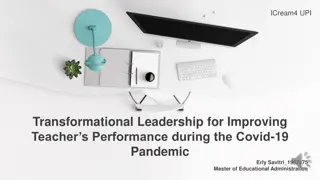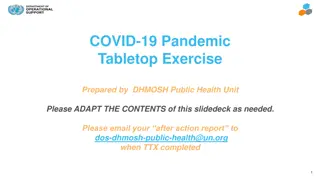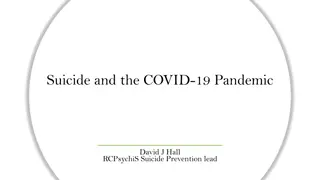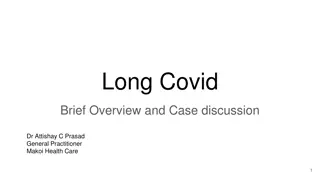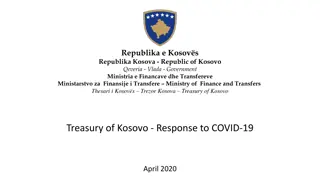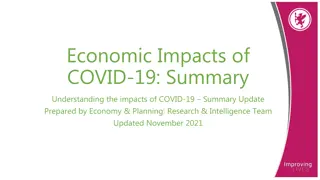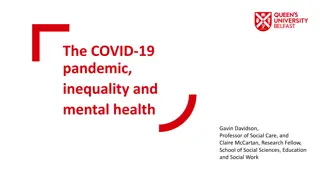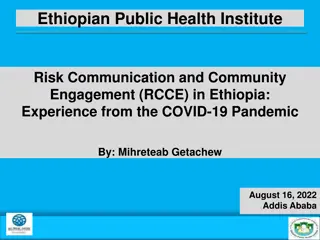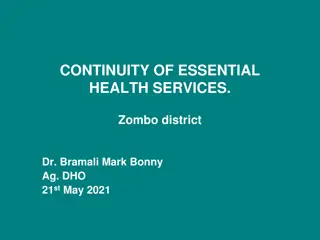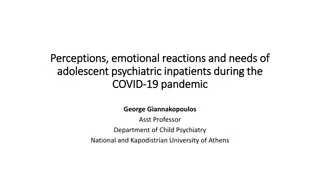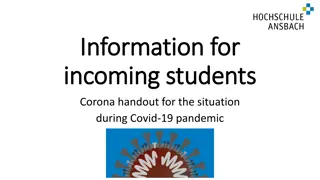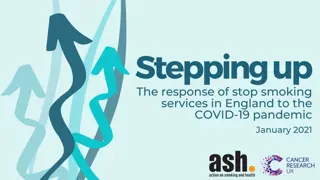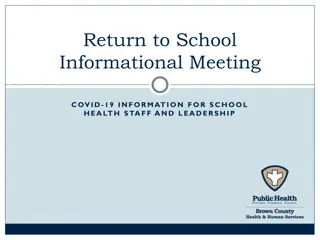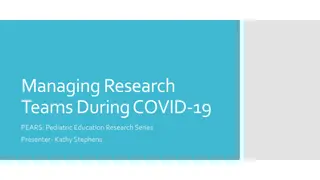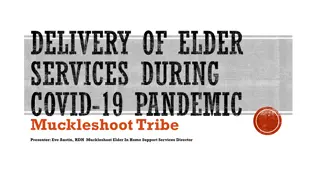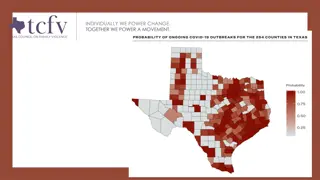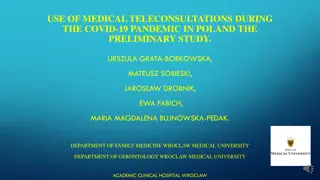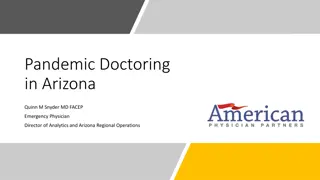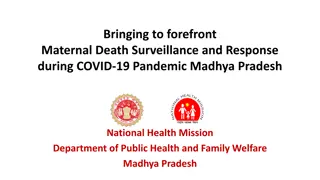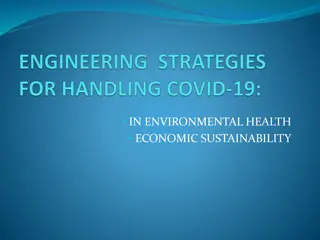Understanding Infodemics in Health Communication during the Covid-19 Pandemic
The Covid-19 pandemic has brought forth an infodemic in Indian society, where misinformation and disinformation spread rapidly, leading to mental health issues. This study by Dr. Sharmila Kayal and Ms. Ruma Saha delves into how communication, especially in health-related matters, is managed amid the infodemic. Through content analysis of national dailies, the focus is on combating fake news and misinformation to ensure accurate health communication.
Download Presentation

Please find below an Image/Link to download the presentation.
The content on the website is provided AS IS for your information and personal use only. It may not be sold, licensed, or shared on other websites without obtaining consent from the author. Download presentation by click this link. If you encounter any issues during the download, it is possible that the publisher has removed the file from their server.
E N D
Presentation Transcript
Effective Health Communication Mediated in Indian Society Author Name- Dr. Sharmila Kayal, Ms. Ruma Saha Designation: Associate Professor*, Doctoral Research Scholar** Affiliation: Department of Communication Management, School of Media and Communication, Adamas University, Barasat, Kolkata- 700126*, Department of Journalism and Mass Communication, Manipal University Jaipur, Rajasthan, India**. E Mail: sharmilakayal@gmail.com, ruma.saha.kolkata@gmail.com
Introduction Covid-19 pandemic has created a situation which demand a sustainable change in behaviour of everyone to handle the situation effectively. During this pandemic a phenomena has arisen alongside is infodemic which is a situation when there is abundant of information but veracity of information is questionable and it leaves people to make right decision on the basis of such information. The infodemic is a serious problem during pandemic is capble of creating mental disturbance, depression and anxiety at large. (1) During Covid-19 pandemic lockdown in India infodemic phenomenon has crippled the entire society at large. In this age of social media infodemic get amplified and affect most of the young mind to make informed decision. During this time two more words associated with infodemic emerged severely that is misinformation and disinformation. Misinformation is false information created for misleading people. Disinformation is false information spread coveted to influence public opinion. It is also called black propaganda . (2)
Introduction Misinformation Vs Disinformation: Misinformation is mainly false news or inaccurate information in circulation with or without any definitive intention or purpose for it. Whereas disinformation is false news or misleading information spread covertly or purposefully or intentionally for spreading any propaganda to influence public opinion. (3) Fake news: Disinformation further contributed to the category of fake news which are created for purpose of spreading false information with a propaganda of influencing public opinion. Apart from this another word identified by WHO during pandemic is Go viral which implies spreading and forwarding soe information without verification of authenticity of information or news. This is a part of fake news and spread mechanism of fake news of fake news. (3)
Introduction Another important word emerged during pandemic is deepfakes which deals with new audio, image, video of disinformation content. They are very difficult to identify and distinguished from real news and its spreading capacity is very fast due to certain words commonality with original content. Many a times it is seen that some of different person is imposed on a different situation to create this type of deep fakes. (3) This paper will study how communication is done during pandemic in Indian society despite the presence of all these malice of infodemics. The is focused on two national dailies for doing content analysis of how they cover the health related issues during this pandemic period by combating fake information or misinformation.
Literature Review In a recent research on Underpinnings of Pandemic Communication in India: The Curious Case of COVID-19 by S.M. Gavaravarapu et.al published on 2021 focused on different communication during pandemic.The researchers tried to find interlinkage between health communication with other factors that influence social determinants during Covid-19 pandemic situations requires strategic shift in economic policies, political system, development policies etc. (S.M. Gavaravarapu et.al.,2021). facet of health Another recent article was published on Health communication through folk media: a study based on Yakshagana A South Indian dance drama on Covid-19 by K.V. Padmananbha et.al on 2020. Researchers focused on case study of Yakshagana performance with the aim of spreading awareness about Covid-19 in Southern part of India. It a particular dance-drama created for spreading social awareness campaign and also perform a sort of health communication at ground level. Researchers have applied reinforcement theory persuasion and attitude change theories and have done thematic analysis as well as online survey for data collection. The result showed that speech, music, body language which are important element of Yakshagana style of communicating health messages.(K.V. Padmananbha et.al., 2020).
Literature Review Recent research paper is published on Fighting infodemic: Need for robust health journalism in India by D.C. Sharma et.al on 2020. The researchers focused on examining role of health communication during pandemic in context of infodemic . The researchers in their result focused on need for improvement of credibility and quality of health journalism in India. They also highlighted on capacity building requirement for media person like fact checking to boast quality of report. In the result they have also highlighted need for more communication between media and health expert.(D.C. Sharma et.al .,2020)
Research Gap There are research done in the area of media communication during pandemic and infodemic and there is also research done in the area of effectiveness of folk media as tools of health communication in souther parts of India during Covid-19 pandemic. But there is hardly any research to analyse the area of how mediated health communication survived this infodemic atmosphere in Indian society during covid-19 pandemic .
Methods and Design The present study tries to explore and understand the media s coverage by analyzing two national dailies focus on public health as their coverage. The sampling framework is purposive in nature and this will analyze the media s coverage of public health as national coverage through content analysis method. The front page of two national dailies for the period of one year (Nov 2020 to Nov 2021)has been taken into consideration. This study also try to understand the issue, agenda and objective for its coverage and how this also navigates in combating fake content or misinformation through their intended messages.
Findings/Analysis The studied news outlets differed in the amount of news media coverage related to COVID-19 from 1 Nov through 15 August 2021). The amount of coverage increased notably in Nov as case rates climbed in the country, subsequently decreasing gradually in May and June 2021 while case rates also declined. Across the 24 randomly sampled days, the 12 studied news outlets published 1,430 articles related to COVID-19. Of these, an estimated 321 articles (23.4%) were eligible for inclusion in this study that is, as news reporting or analysis relevant to the country of publication and containing a direct focus on COVID-19 public health or policy information. Articles with a direct focus on COVID-19 public health or policy information (to a small or large extent) could be coded for the scientific quality of the reporting of this information and its sensationalism.
Findings/Analysis We collected a manageable, well-defined random sample of 331 news media articles satisfying our eligibility criteria for coding of scientific quality and sensationalism (SI Coding Tool and Dataset S1). Six questions each for scientific quality and for sensationalism were evaluated on a scale from 1 to 5 (5 corresponding to highest scientific quality or sensationalism, 1 corresponding to lowest scientific quality or sensationalism).
The topics of pandemic media coverage News media articles were categorized based on the societal sectors (up to 2 per article) that were the primary focus of each article. The sectors, related to healthcare, leisure and entertainment, economics and commerce, government and politics, and other social services, are listed in full in front pages. Although all analyzed articles contained information on the public- health effects of COVID-19 or measures to limit its spread topics of focus differed widely, for example including recreation, the arts, transportation, or daycare, not just medical facilities or vaccine research.
Discussions Managing the public health and societal risks of a pandemic requires iterative, informed decision-making by governments, individuals, and the private sector. News media play a central role in communicating public health and policy information, establishing accountability for decision-making, and shaping public perceptions through the number of news reports, their content, and their tone (Klemm et al., 2016; Reintjes et al., 2016). For news outlets spanning the political spectrum with contrasting public-health outcomes and policy responses based on a random sample of days, coverage related to COVID-19 increased substantially in Aug 2021 and declined gradually thereafter in May and June 2021. Understanding this news media reporting in the early stages of COVID-19 response provides important lessons for ensuring the accessibility of information in support of public health and gauging its degree of effectiveness in creating accountability for policy decisions.
References 1. https://www.frontiersin.org/articles/10.3389/fpubh.2020.573397/full 2. https://www.merriam-webster.com/dictionary/disinformation 3. https://guides.lib.uw.edu/c.php?g=345925&p=7772376 4. https://www.who.int/campaigns/connecting-the-world-to-combat-coronavirus/how-to-report-misinformation-online 5. Gavaravarapu, S. M., & Vemula, R. K. (2021). Underpinnings of Pandemic Communication in India: The Curious Case of COVID-19. In Communicating COVID-19 (pp. 185-202). Palgrave Macmillan, Cham. 6. Padmanabha, K. V., & Kumar, S. (2020). Health communication through folk media: a study based on Yakshagana A South Indian dance drama on Covid-19. Mass Communicator: International Journal of Communication Studies, 14(3), 20-26. 7. Sharma, D. C., Pathak, A., Chaurasia, R. N., Joshi, D., Singh, R. K., & Mishra, V. N. (2020). Fighting infodemic: Need for robust health journalism in India. Diabetes & Metabolic Syndrome: Clinical Research & Reviews.


